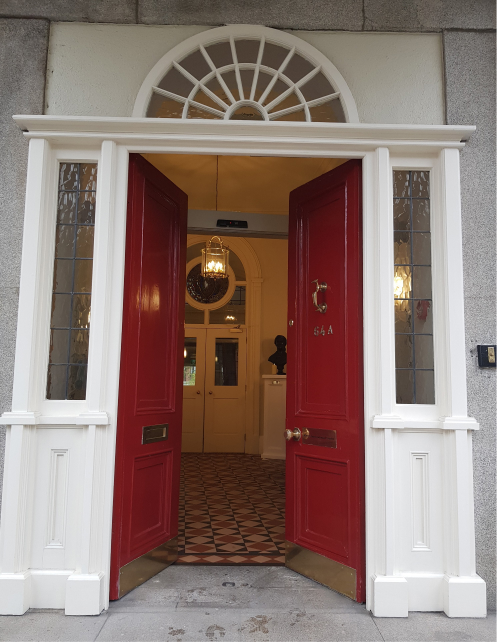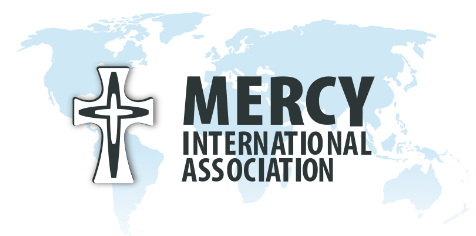Discover the story of Catherine McAuley by exploring this virtual tour of Dublin. The tour visits many landmarks of importance in the life of Catherine and the history of the Sisters of Mercy.
)
1. Mercy International Centre
64A Lower Baggot Street
Mercy International Centre
64A Lower Baggot Street
The first House of Mercy opened here on 24 September 1827 as a school for poor young girls and a residence for homeless girls and women. Anna Maria (Mary Ann) Doyle and Catherine Byrn were Catherine McAuley’s first co-workers.
2. Scoil Chaitríona
59 Lower Baggot Street
Scoil Chaitríona
59 Lower Baggot Street
The school on the grounds where the first Mercy House was opened in 1827 and on the very place where our Lady of Mercy Training college was founded by Catherine McAuley in the early 1830s
Today, boys and girls from junior infants to sixth class attend Scoil Chaitríona.
)
3. Grand Canal
Grand Canal Road
Grand Canal
Grand Canal Road
The waterway was opened in the late 18th Century for transporting goods and passengers. From Portobello, third bridge west from Baggot Street, Catherine travelled in 1836 to make the first Foundation beyond Dublin - in Tullamore.
)
4. Sir Patrick Dunn's Hospital
Grand Canal Road
Sir Patrick Dunn's Hospital
Grand Canal Road
Catherine and her companions began visiting the patients here in 1828. At first, she drove in her carriage, and was welcomed because of her connection with those in the medical profession. Then she sold the carriage and began an organised schedule of visitation of the sick in nearby hospitals and in their homes.
The hospital which opened in 1808 was closed in 1986 and the services transferred to other hospitals, mainly Saint James's Hospital.
)
5. St. Andrews
44 Westland Row
St. Andrews
44 Westland Row
This church was the first to be built on a main thoroughfare after this was permitted by the Catholic Emancipation Act of 1829. Construction started in 1832, it opened for public worship in 1834 but was not completed until 1837.
Daniel O’Connell, a parishioner, began fundraising in the early 1830's. He donated the painting 'Martyrdom of Thomas a Beckett' and also a wine-cooler to be used as the Baptismal Font.
Mercy International Centre is in this parish.
)
6. St Mark's
Corner of Pearse/Mark Street
St Mark's
Corner of Pearse/Mark Street
Here, Catherine’ sister Mary married William MacAuley and here they are both buried. Unfortunately, their tombstones cannot be deciphered.
)
7. Cholera Hospital
Townsend Street
Cholera Hospital
Townsend Street
Between Tara and D’Olier Street was the Cholera Hospital which the Sisters were asked to manage during the epidemic in 1832. There was a chapel nearby before St Andrew’s was built and later a school where the Sisters taught.
)
8. St Mary's Pro Cathedral
Marlborough Street
St Mary's Pro Cathedral
Marlborough Street
Opened in 1825, it replaced St Mary’s Chapel in Liffey Street where James McAuley had been a benefactor and Catherine had attended Mass. Archbishop Murray who opened the Cathedral is buried here.
Beneath the carved sculpture of Cardinal Cullen are fine depictions of the Sisters of Mercy engaged in charitable works. (Left hand side aisle if you enter from Marlborough Street).
)
9. Middle Abbey Street
Middle Abbey Street
Middle Abbey Street
Middle Abbey Street
Somewhere here, Catherine helped in Fr. Nugent’s scool and taught needlework to young women. Their work was sold in a shop next door.
)
10. Site of the Apothecaries' Hall
Mary Street
Site of the Apothecaries' Hall
Mary Street
Mary street is very significant in our Mercy Story. Down from the ILAC Centre was the site of the the Apothecaries' Hall where medical students (including Catherine’s Brother and Brother-in-Law) were trained. Today, look up above street -level to notice the older buildings.
Catherine spent several years here with the Armstrong family and here she met the Callaghans who also lived in Mary Street. While residing here, Catherine attended the little chapel in Liffey Street where her father and uncle had been benefactors.
(The ILAC Centre now covers the spot.
)
11. Jervis Street Hospital
Jervis Street
Jervis Street Hospital
Jervis Street
Now a shopping centre, this was the site of the Charitable Infirmary. At the top of the escalator in the shopping centre a plaque notes that the Sisters of Mercy were in charge of the Hospital for 129 years from 1854 until it closed in 1984. The façade is preserved. Many freedom fighters were nursed here during the Easter Rising in 1916
)
12. Arran Street East
Arran Street East
Arran Street East
Arran Street East
Catherine chose to live here with her uncle Owen Conway after her mother died - until he went bankrupt. She then joined her brother and sister with the Armstrongs in Mary Street.
)
13. Presentation Convent
Georges Hill
Presentation Convent
Georges Hill
This is where Catherine, Mary Ann Doyle and Elizabeth Harley came here to do their novitiate training. They were professed here on 12th December 1831
)
14. St Paul's
Arran Quay
St Paul's
Arran Quay
Catherine was confirmed and probably made her First Communion in the earlier St Paul’s Church here - near the Conway home
)
15. 52 Queen Street
52 Queen Street
52 Queen Street
52 Queen Street
After her husband died, Elinor McAuley and her family moved here to property they owned - in the then fashionable part of Dublin city.
)
16. Royal Hospital
Military Road, Kilmainham
Royal Hospital
Military Road, Kilmainham
Founded in 1684 as a retirement home and infirmary for military veterans, Catherine’s sister and her husband William resided here in Military Road when he became assistant surgeon at this Hospital. It was at their home that Catherine first met Mary Ann Doyle. In 1827, Catherine came here to care for Mary during her last illness.
The building was restored by the Government in 1984 and opened as the Irish Museum of Modern Art (IMMA) in 1991
)
17. Adam and Eve's Church
Merchant's Quay
Adam and Eve's Church
Merchant's Quay
This church near Merchant's Quay is so-called because in Penal times the faithful came through a tavern of that name on Cook Street in the room where Mass was said. When the Franciscan Fathers needed more land, Catherine’s father made some of his property available.
)
18. Copper Alley
Fishamble Street
Copper Alley
Fishamble Street
Copper Alley is said to have taken its name from the copper money once coined and distributed there. In 1767, Catherine’s father leased the Queen’s Head Tavern on the south side of Copper Alley.
)
19. Fishamble Street
Fishamble Street
Fishamble Street
Fishamble Street
This is the oldest street in Dublin, dating back from medieval times. Here, Handel’s ‘Messiah’ was first performed in 1742. The family resided in this alley when baby James was born and when Catherine’s father died. He also owned two properties on the corner of Fishamble and Lord Edward St.
Access to Fishamble Street today is only available from Lord Edward Street.
)
20. St Michael and John's Church
Essex Quay
St Michael and John's Church
Essex Quay
In this Church which faces the Liffey but is quite near Copper Alley, Catherine’s brother James was baptized.
)
21. Doyle Family Home
14-15 St. Andrew’s Street
Doyle Family Home
14-15 St. Andrew’s Street
Anna Maria Doyle , known in religious life as Mary Ann Doyle, Catherine’s first companion, lived with her family at this address. We know very little about Anna Maria’s own life while she lived there.
During the construction of the first House of Mercy, now Mercy International Centre, many people wondered what was the strange looking building on the corner of Baggot Street and Herbert Street, Dublin. Bonnie Brennan rsm, quoting the Derry manuscript, writes in her book It Commenced with Two, 'One passer by in particular,... "remarked the building with indescribable attraction", her name was Anna Maria Doyle. Seeing her interest in the progress of the construction, the man in charge offered to give her a guided tour, and gave her some idea of the intentions of the owner, Catherine McAuley. Fired with enthusiasm, Anna Maria lost no time in seeking an introduction to Catherine McAuley who received her "with gratitude and delight" in the home of her sister and brother-in-law...in the spring of 1827.'
More information about Mary Ann can be found here.
)
22. St Teresa's
Clarendon Street
St Teresa's
Clarendon Street
Often the Sisters and ‘House of Mercy” women walked to Mass here. Carmelite Fathers L’Estrange and O’Hanlon were very supportive of Catherine. There is a fine Hogan sculpture under the High Altar. The first thirteen Sisters who died are buried in the vaults (which are closed to visitors). Their names are inscribed on a commemorative plaque inside the Church.
)
23. Coolock House
St Brendan's Drive Coolock
Coolock House
St Brendan's Drive Coolock
Catherine’s association with Coolock House began in 1803 when she went there to live with William and Catherine Callaghan, a wealthy couple who were friends of the Armstrongs.
She acted as companion to Mrs Callaghan who was chronically ill, and assumed some responsibility for running the household. Mrs Callaghan died in 1819 and William Callaghan in 1822 naming Catherine as his sole heiress. Her inheritance made possible the building of the House of Mercy in Baggot Street and the beginning of the Sisters of Mercy.
In 1955 the Dublin Sisters of Mercy re-purchased Coolock House which Catherine had sold, at first using the rooms as classrooms until a new school was built. Following renovations to the house a new community took up residence there.
Mercy International Centre has been established in the basement at Coolock ‘providing an environment of peace and rest where persons from all walks of life are welcomed and find hospitality, spirituality, caring and healing’.
The Dublin Sisters re-purchased the house in 1954 and a community is in residence. In consideration for them, please only visit as a group after contacting them. (Bus 27 departs from Talbot Street. Ask to be let off at St Brendan’s Drive.)
)
24. St Brendan's
Coolock Village
St Brendan's
Coolock Village
St Brendan’s is a parish in Coolock, named for St Brendan, one of the key figures in the early Irish Church, best known for the story of his voyage across the Atlantic ocean.
There has been a church in Coolock since the earliest times. When she lived with the Callaghan’s, Catherine attended Mass here. The church at the time was a small thatched building. It was through Catherine’s participation in the parish there that she met Fr. Nugent who was significant in that part of her story and ministry.
The present parish church, located between the main street of Coolock village and the Malahide Road, was dedicated in 1974.
)
25. Stormanstown House
Ballymun
Stormanstown House
Ballymun
Catherine’s birth place and early years were spent in a house in Stormanstown, just north of Dublin on the Ballymun Road. It is not certain what style of house it was – lodge, coach house or smaller house, other than it was of the period.
Today the Stormanstown area is called Ballymun
)
26. Prospect Cemetery
Glasnevin (Finglas Road)
Prospect Cemetery
Glasnevin (Finglas Road)
Two of Catherine’s nephews are buried here in an unmarked grave: JD 82.
Robert McAuley: 6.1.1840.
James McAuley: 1.5.1840


)
)
)
)
)
)
)
)
)
)
)
)
)
)
)
)
)
)
)
)
)
)
)
)
)
)
)
)